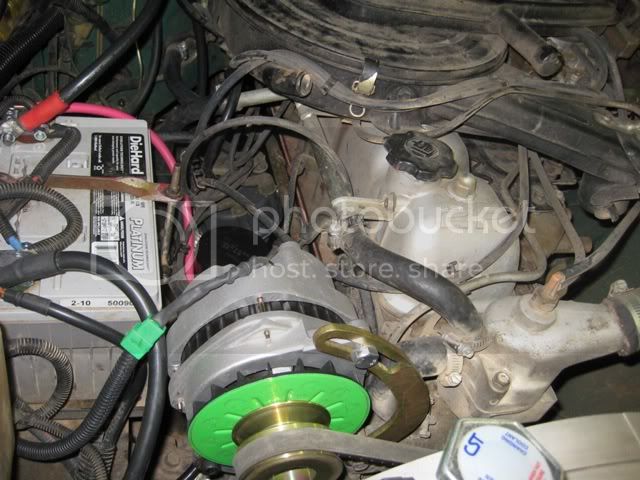can we also use a internal reg alt from a 1985 fj60? its a 50 amp alt.
anyone?
Im assuming its fine.....

Follow along with the video below to see how to install our site as a web app on your home screen.
Note: This feature may not be available in some browsers.
This site may earn a commission from merchant affiliate
links, including eBay, Amazon, Skimlinks, and others.
can we also use a internal reg alt from a 1985 fj60? its a 50 amp alt.

Might work fine but I don't trust remanufactured electrical parts from any auto parts store. I would rather go w/the OEM unit Jim C. suggested in post 9.
John
I went with the 200 amp Mean Green that is a bolt-in with an internal VR. I've had it for a number of years with no issues. I mounted an aux fuse panel where the original external VR was mounted on the firewall which supports various critical components. As you can see, the Mean Green came with a dual pulley that supports the Toyota width belts (17mm). I ran 4 gauge heavy duty welding cable from the alternator to the battery. I also ran 12 gauge wire from the main fuse panel to the internal VR that turns it on with the ignition key. I went to the GM dealership and got the connector kit for this alternator that uses Teflon coated wires. It is by far the best connector you can find. Once this alternator gets above the initial idle the voltage stays above 13v (more like 14 volts) and the lights do not dim at idle. Basically, I bypassed the wiring harness associated with the original VR and alternator without removing the old w
iring. I wrapped the old VR and alternator connectors with electrical tape to keep them clean and maintain the option to retrofit.
I went with the 200 amp Mean Green that is a bolt-in with an internal VR. I've had it for a number of years with no issues. ... As you can see, the Mean Green came with a dual pulley that supports the Toyota width belts (17mm). I ran 4 gauge heavy duty welding cable from the alternator to the battery. ... Once this alternator gets above the initial idle the voltage stays above 13v (more like 14 volts) and the lights do not dim at idle.


Thanks, you had some good ideas here. I have resent them to my mech for advice.
I have one questons though, I am looking at your avatar, assuming that is your rig, and see only a winch, so why 200 amp alt?
purportedly, the amp gauge cannot handle more than stock 45 amp draw - don't route wiring with a higher amp draw through the ammeter
purportedly, the amp gauge cannot handle more than stock 45 amp draw - don't route wiring with a higher amp draw through the ammeter
Does anyone know of a good after market ammeter I could use?

The last factor for this is the ammeter. Does anyone know of a good after market ammeter I could use?
I know this may be overkill, a bit, LOL. But preparing for worst case scenario.
Yes. And they are $50 reman from rockauto, with internal regulator. And they are 60A.can we also use a internal reg alt from a 1985 fj60? its a 50 amp alt.
Yes. And they are $50 reman from rockauto, with internal regulator. And they are 60A.